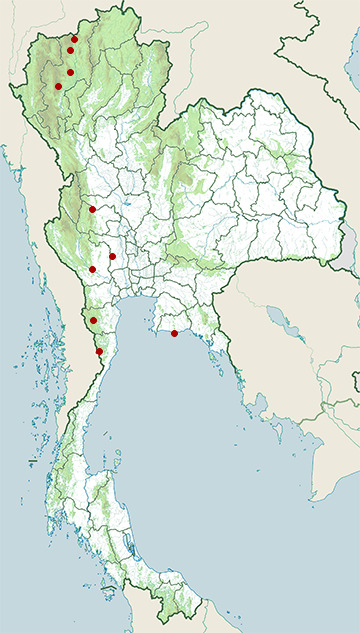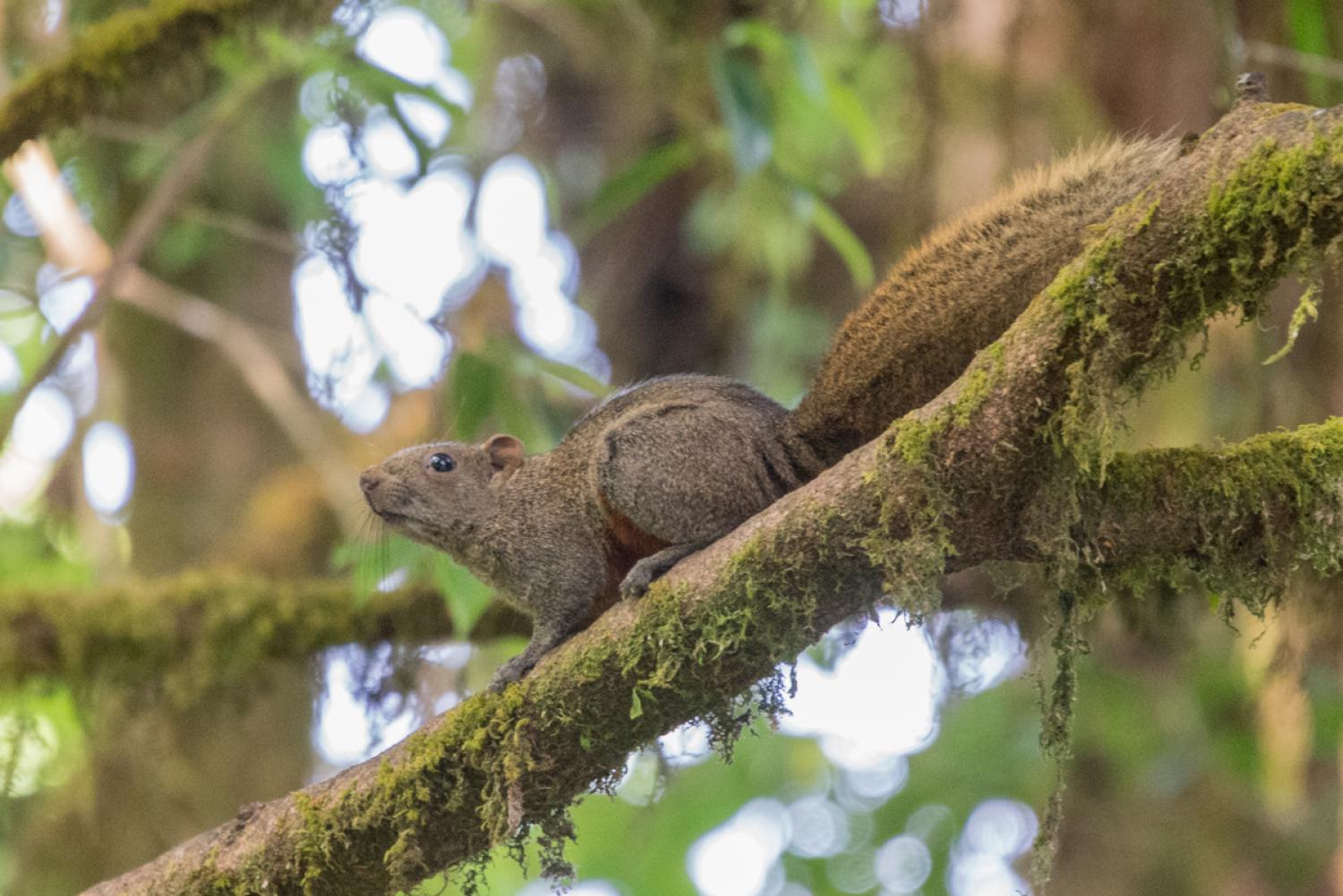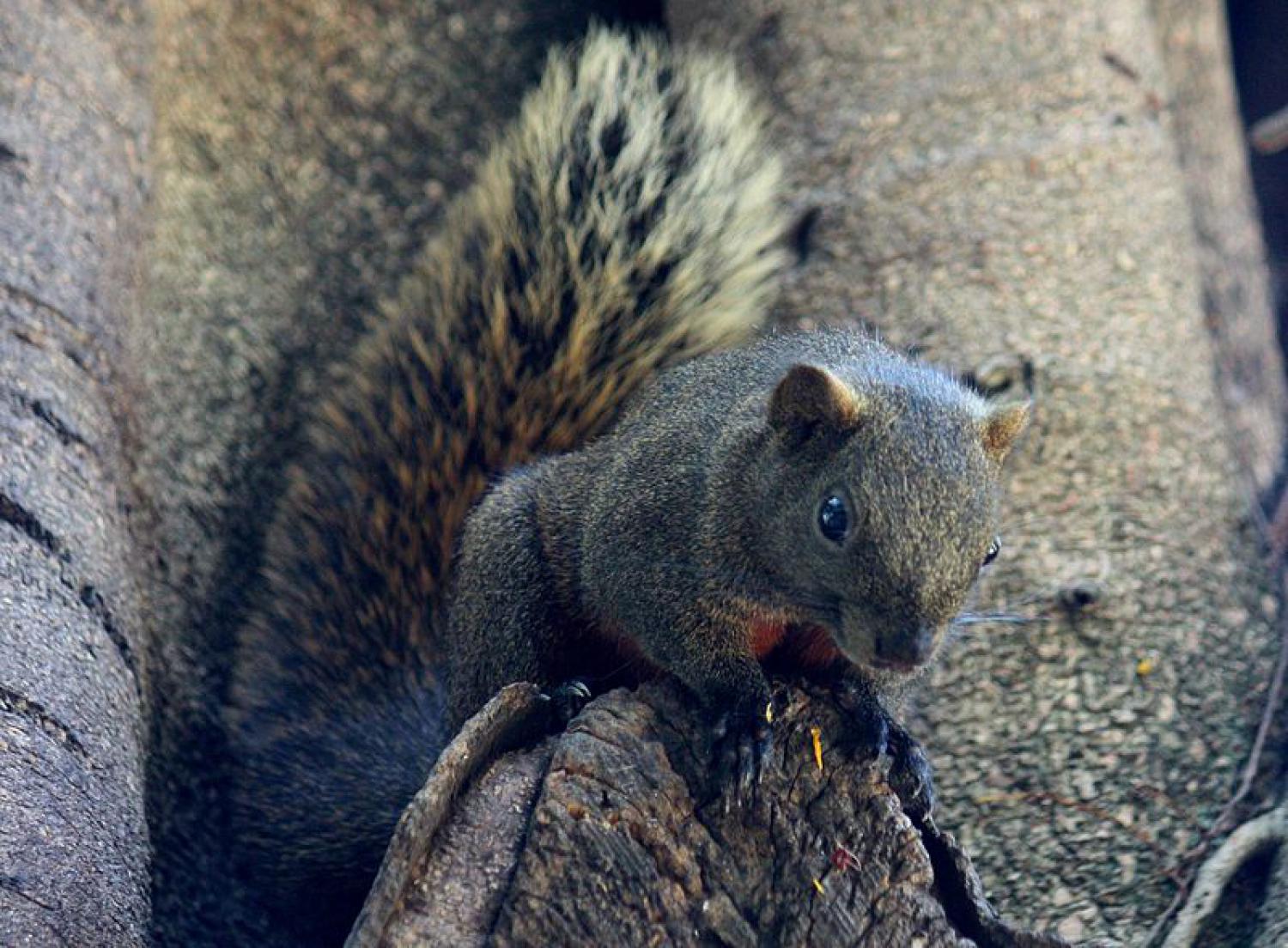Species of Thailand
Pallas's squirrel
Callosciurus erythraeus
(Peter Simon Pallas, 1779)
Pallas's squirrel (Callosciurus erythraeus), also known as the red-bellied tree squirrel, is a species of squirrel native to China, Taiwan, India, and Southeast Asia.
Description
Pallas's squirrel is a medium-sized tree squirrel, with a head-body length of 16 to 28 cm, and a tail 11 to 26 cm in length. Both sexes are of similar size and appearance, and weigh between 310 and 460 g sigfig=2. The colour of the pelt varies considerably between the many different subspecies, but is generally brownish on the upper body with a more reddish tint on the belly, and often with some black on the tail. The precise pattern and shades of the fur are often used to distinguish subspecies from one another, but make it difficult to distinguish the species as a whole from other, similarly variable, tree squirrel species.
Subspecies
Over 30 subspecies have been identified, although not all are recognised by all authorities:
- C. e. erythraeus
- C. e. atrodorsalis
- C. e. bartoni
- C. e. bhutanensis
- C. e. bonhotei
- C. e. castaneoventris
- C. e. erythrogaster
- C. e. flavimanus
- C. e. gloveri
- C. e. gongshanensis
- C. e. gordoni
- C. e. griseimanus
- C. e. griseopectus
- C. e. haringtoni
- C. e. hendeei
- C. e. hyperythrus
- C. e. intermedius
- C. e. michianus
- C. e. ningpoensis
- C. e. pranis
- C. e. qinglingensis
- C. e. rubeculus
- C. e. shanicus
- C. e. siamensis
- C. e. sladeni
- C. e. styani
- C. e. thai
- C. e. thaiwanensis
- C. e. wuliangshanensis
- C. e. wulingshanensis
- C. e. zhaotongensis
- C. e. zimmeensis
Distribution and habitat
Pallas's squirrel is found throughout much of southeastern Asia, including far eastern India, Bhutan, northern and eastern Myanmar, Vietnam, parts of Cambodia and Laos, much of Thailand, northern peninsular Malaysia, Taiwan, and southern and eastern China, including Hainan . Within this region, they are found within a range of forest habitats below 3000 m elevation, including tropical and subtropical evergreen, deciduous broadleaf, and subalpine conifer woodlands.
Populations have been introduced in the Buenos Aires Province of Argentina, Dadizele in Belgium (where initially mistaken for Père David's rock squirrel), the Netherlands, Cap d'Antibes in France, and Japan. In these regions it is considered an invasive species, as it can cause considerable damage to trees and may outcompete native wildlife such as the red squirrel. In 2016, the species was included in the European list of Invasive Alien Species of Union concern (the Union list). This implies that it cannot be imported, bred, transported, commercialized, or intentionally released into the environment in the whole of the European Union.
Biology
Like all tree squirrels, Pallas's squirrels are primarily herbivorous. They eat a wide range of different foods, and have differing diets in different parts of their broad range. However, primary foodstuffs include leaves, flowers, seeds, and fruit. They also eat small quantities of insects, as well as occasional bird eggs.
The squirrels breed throughout the year, and may mate again as soon as they have weaned a previous litter. Gestation lasts 47 to 49 days, and results in the birth of up to four young, with two being typical. The young leave the nest at 40 to 50 days old, and are sexually mature at one year of age. They have lived for up to 17 years in captivity.
Behaviour
Pallas's squirrels are diurnal, and inhabit much of the forest canopy, and construct both leaf nests 7 to 18 m above the ground, and less commonly, in burrows. Females occupy home ranges of just 0.5 to 0.8 ha, which usually do not overlap, while males occupy much larger ranges of 1.3 to 3.8 ha, which overlap with those of both nearby males and females. Like many other squirrels, they have been observed to cache acorns in the autumn.
The squirrels make calls to warn neighbours of predators, and have been observed to mob tree-climbing snakes, with females protecting young being particularly likely to join in. Males also make loud calls both prior to and after mating.
This article uses material from Wikipedia released under the Creative Commons Attribution-Share-Alike Licence 3.0. Eventual photos shown in this page may or may not be from Wikipedia, please see the license details for photos in photo by-lines.
Scientific classification
- Kingdom
- Animalia
- Phylum
- Chordata
- Class
- Mammalia
- Order
- Rodentia
- Family
- Sciuridae
- Genus
- Callosciurus
- Species
- Callosciurus erythraeus
Common names
- English:
- Pallas's squirrel
- Formosan squirrel
- Red-bellied squirrel
- Red-bellied tree squirrel
Subspecies
Callosciurus erythraeus atrodorsalis
Callosciurus erythraeus bartoni
Callosciurus erythraeus bhutanensis
Callosciurus erythraeus bonhotei
Callosciurus erythraeus castaneoventris
Callosciurus erythraeus erythraeus
Callosciurus erythraeus erythrogaster
Callosciurus erythraeus flavimanus
Callosciurus erythraeus gloveri
Callosciurus erythraeus gongshanensis
Callosciurus erythraeus gordoni
Callosciurus erythraeus griseimanus
Callosciurus erythraeus griseopectus
Callosciurus erythraeus haringtoni
Callosciurus erythraeus hendeei
Callosciurus erythraeus hyperythrus
Callosciurus erythraeus intermedius
Callosciurus erythraeus michianus
Callosciurus erythraeus ningpoensis
Callosciurus erythraeus pranis
Callosciurus erythraeus qinglingensis
Callosciurus erythraeus rubeculus
Callosciurus erythraeus shanicus
Callosciurus erythraeus siamensis
Callosciurus erythraeus sladeni
Callosciurus erythraeus styani
Callosciurus erythraeus thai
Callosciurus erythraeus thaiwanensis
Callosciurus erythraeus wuliangshanensis
Callosciurus erythraeus wulingshanensis
Callosciurus erythraeus zhaotongensis
Callosciurus erythraeus zimmeensis
Synonyms
- Callosciurus sladeni
- Callosciurus flavimanus
Conservation status

Least Concern (IUCN3.1)
Photos
Please help us review our species pages if wrong photos are used or any other details in the page is wrong. We can be reached via our contact us page.
Range Map

- Chiang Dao Wildlife Sanctuary
- Doi Inthanon National Park
- Doi Suthep - Pui National Park
- Kaeng Krachan National Park
- Khao Laem Ya - Mu Ko Samet National Park
- Kui Buri National Park
- Lan Sak District, Uthai Thani
- Mueang Kanchanaburi District, Kanchanaburi
- Pha Daeng National Park
- U Thong District, Suphan Buri


